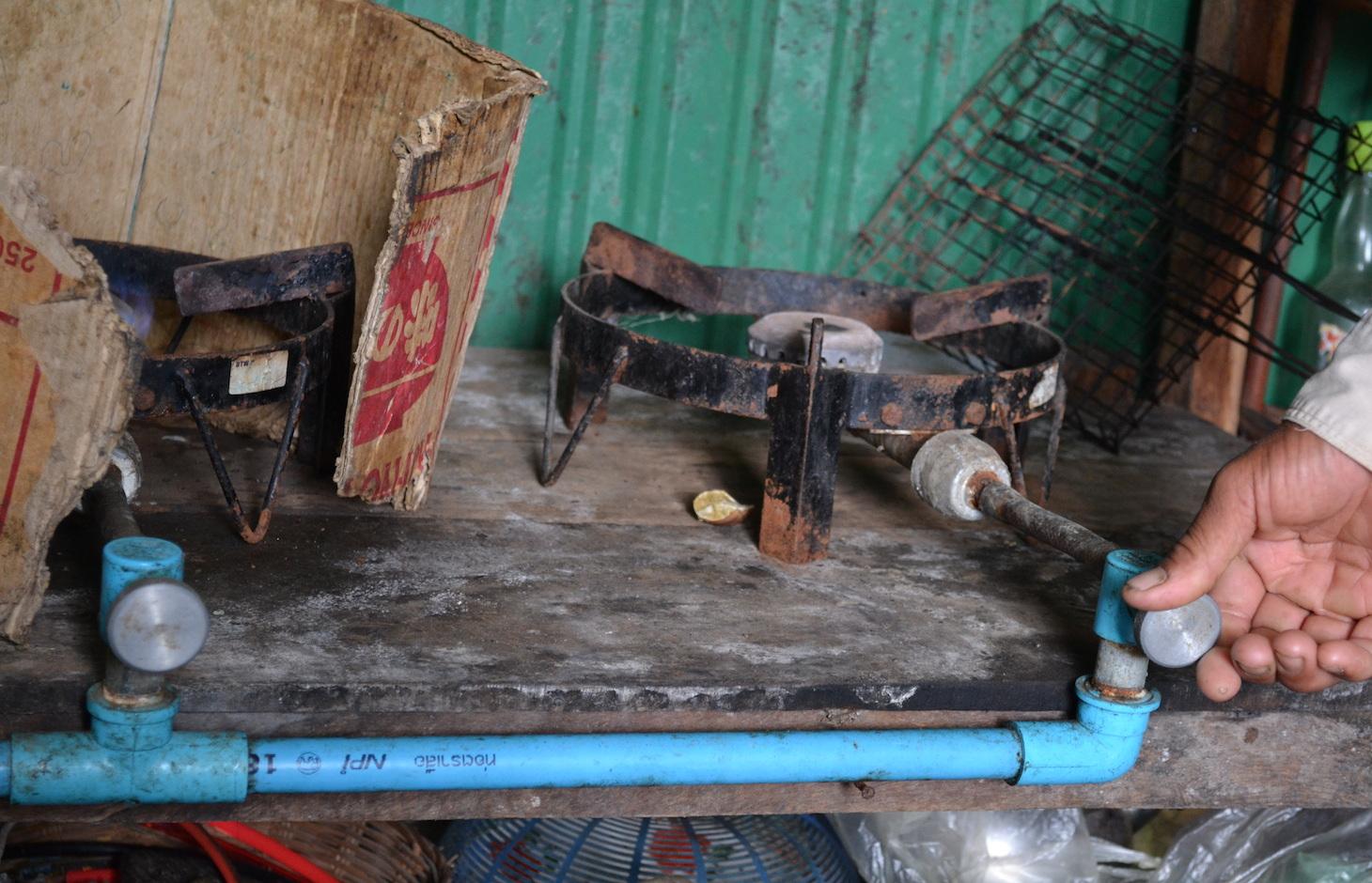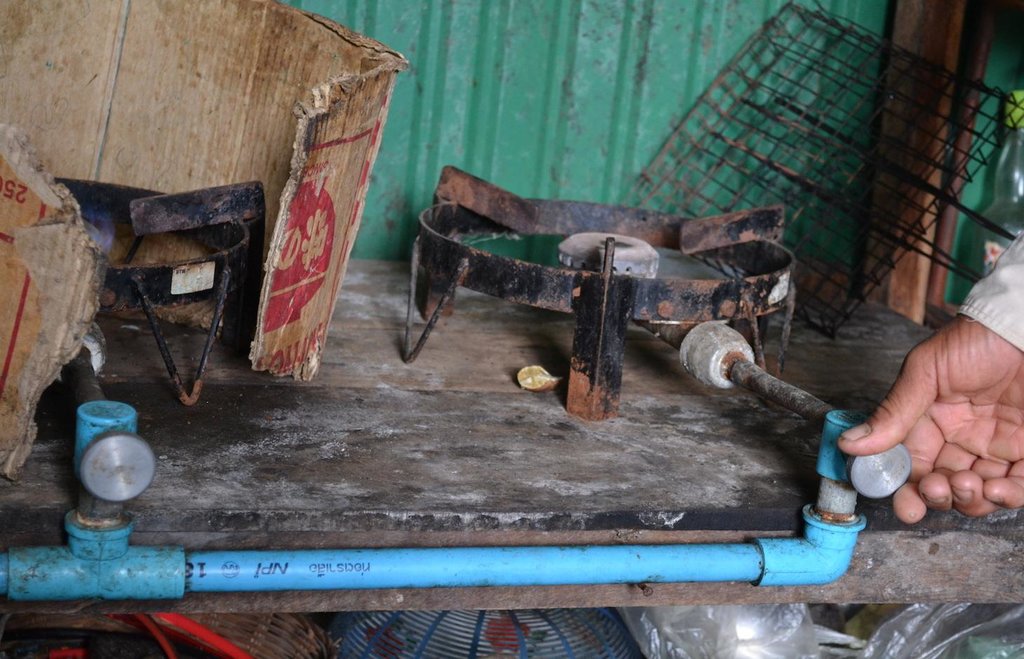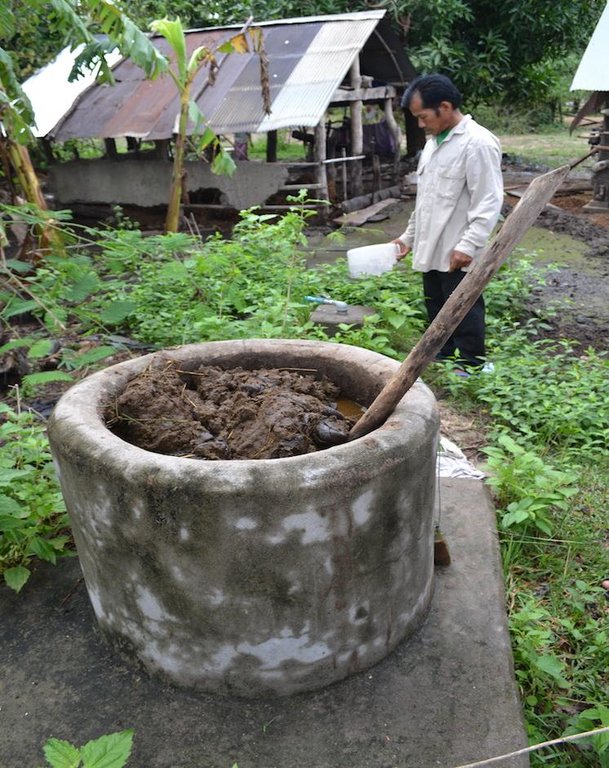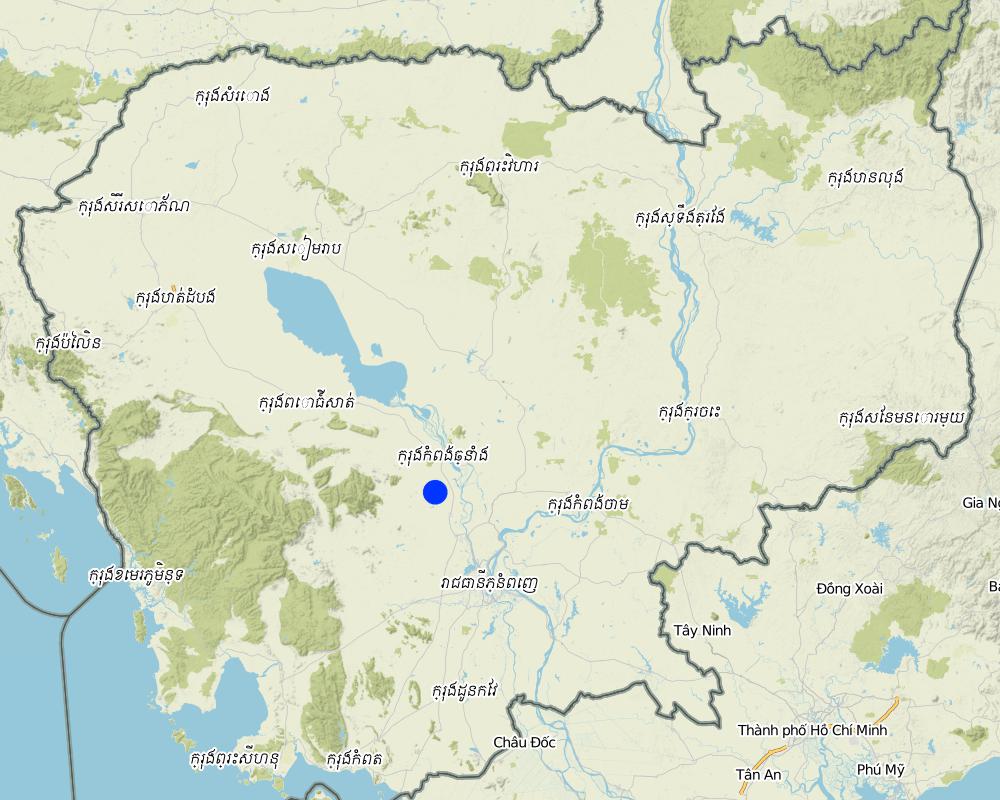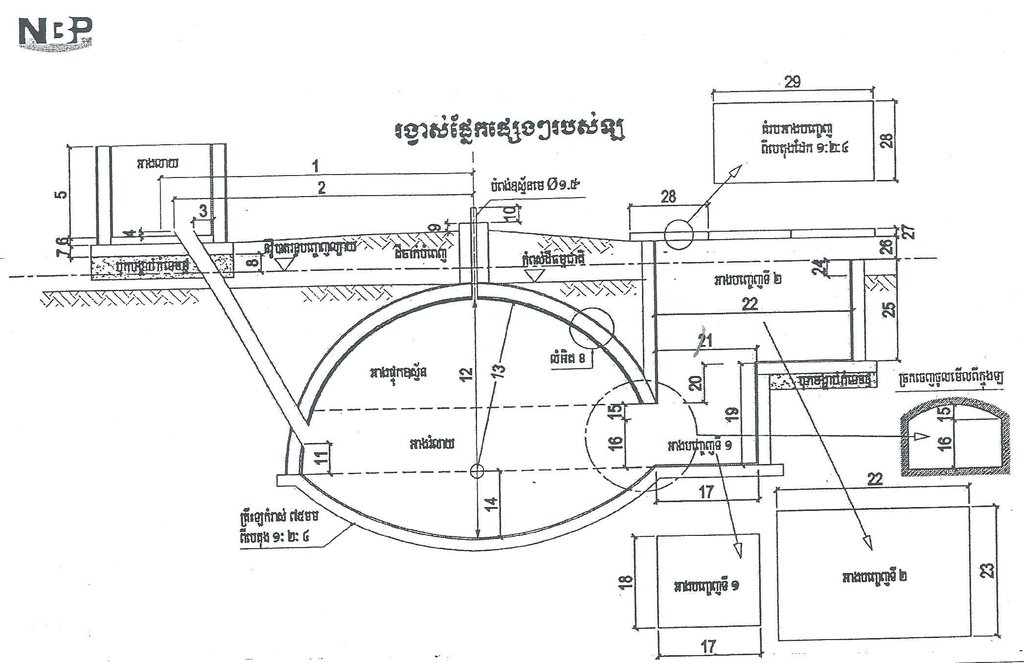Biogas system at household level fed daily with cattle manure [Cambodge]
- Création :
- Mise à jour :
- Compilateur : Christoph Kaufmann
- Rédacteur : –
- Examinateurs : Deborah Niggli, David Streiff, Alexandra Gavilano
ប្រពន្ធ័ឡជីវៈឧស្ម័នប្រើសំរាប់គ្រួសារប្រចំាថៃ្ងដោយប្រើលាមកគោ (Khmer)
technologies_1645 - Cambodge
Voir les sections
Développer tout Réduire tout1. Informations générales
1.2 Coordonnées des personnes-ressources et des institutions impliquées dans l'évaluation et la documentation de la Technologie
Spécialiste GDT:
Khun Lean Hak
SOFDEC/LAREC, www.sofdec.org
Cambodge
Spécialiste GDT:
Pith Khonhel
LAREC
Cambodge
Spécialiste GDT:
Bin Sreytouch
SOFDEC
Cambodge
Spécialiste GDT:
Say Mesa
SOFDEC
Cambodge
Nom du ou des institutions qui ont facilité la documentation/ l'évaluation de la Technologie (si pertinent)
Society for Community Development in Cambodia (SOFDEC) - CambodgeNom du ou des institutions qui ont facilité la documentation/ l'évaluation de la Technologie (si pertinent)
Local Agricultural Research and Extension Centre (LAREC) - Cambodge1.3 Conditions relatives à l'utilisation par WOCAT des données documentées
Le compilateur et la(les) personne(s) ressource(s) acceptent les conditions relatives à l'utilisation par WOCAT des données documentées:
Oui
1.4 Déclaration sur la durabilité de la Technologie décrite
Est-ce que la Technologie décrite ici pose problème par rapport à la dégradation des terres, de telle sorte qu'elle ne peut pas être déclarée comme étant une technologie de gestion durable des terres?
Non
2. Description de la Technologie de GDT
2.1 Courte description de la Technologie
Définition de la Technologie:
Small-scale biogas systems fed with cow manure and water are implemented in order to supply the household with energy for cooking and lighting, as well as to produce fertilizer.
2.2 Description détaillée de la Technologie
Description:
In this case-study, a small-scale biogas system was introduced in order to generate both energy for home consumption and fertilizer. Small-scale biogas systems are implemented in different parts of the world, however the layout thereof varies considerably.
The model used in this case-study consists of different components (cf. technical drawing). First, there is an inlet where the land user puts cow manure mixed with water. On the bottom of the inlet, there is a board which closes the access to the bio-digester situated beneath the inlet. The board can be opened manually by pulling a string. Once the board is open, the fluid components go through a pipe which leads to the bio-digester. In the bio-digester, bacteria transform the organic matter into biogas (mainly methane and CO2) and slurry. At the other end of the digester, there is another pipe (outlet). The outlet is lower than the inlet, and due to the difference in pressure, the slurry is pushed out of the digester. The slurry is dried and applied to the fields two to three times a year with the help of an ox cart. It has similar effects on the plant growth as chemical fertilizer as it does not build up the soil organic matter as much as compost. The biogas, however, is pushed to the pipe situated on top of the digester and can be utilized for domestic uses. The gas is used for cooking and lighting.
The use of biogas allows reducing the expenses on charging batteries for the lighting, as well as reducing the firewood use (usually from deforestation) for cooking. The slurry reduces the expenses on chemical fertilizer in the fields and has the advantage of killing the weed and rice seeds present in the manure and crop residues.
For building the biogas system, there is governmental and NGO support. These two actors finance half of the construction costs. The other half is paid by the land user. Building a biogas system is quite costly, with about 400 $, and not all of the land users in the area can afford paying 50% of its price. However, the costs borne by the land user are paid off within a few years due to reduced expenses on firewood, chemical fertilizer, and charging batteries. The construction itself was undertaken by local companies.
The costs are paid off within a few years due to the reduced expenses on firewood, chemical fertilizer and battery charging.
The analysed area is flat (slope < 2%), tropic (dry and wet season), and the soils are mostly sandy or loamy. The soils contain little organic matter (low soil fertility, acidification, small amount of cattle, area has been deforested a long time ago) and the groundwater table is rather high (1-3 m during the dry season, on the surface during wet season).
Due to climate change, the rainfalls are more erratic, temperatures rise and droughts are more recurrent. Rice is the predominant crop grown in the area, since it serves as staple food (mix subsistence and commercial activities). Rice is often grown in monocultures and harvested once a year. Once the rice is harvested (dry season), the cattle are released to the paddy fields. The cattle is often replaced by hand tractors, which effects the production of manure but allows a higher amount of crop residues on the fields.
As an addition to rice, most land users grow vegetable and fruits in small home gardens (subsistence) and complement their income by producing handicrafts or through off farm income / remittances from family members working in other places. The increasing migration rate (the young generation leaves the villages to work in the cities, garment industry or abroad) results in a decrease of available labour force in the area which has detrimental effects on the agricultural activities. Furthermore, the civil war in the 1970s (Khmer Rouge) led to the loss of agricultural knowledge which different NGOs try to re-establish.
2.3 Photos de la Technologie
2.5 Pays/ région/ lieux où la Technologie a été appliquée et qui sont couverts par cette évaluation
Pays:
Cambodge
Région/ Etat/ Province:
Kampong Chhnang
Autres spécifications du lieu:
Sre Ouk Samlor Sap/Taing Krasaing/Rolear Pha,er
Spécifiez la diffusion de la Technologie:
- répartie uniformément sur une zone
S'il n'existe pas d'informations exactes sur la superficie, indiquez les limites approximatives de la zone couverte:
- 0,1-1 km2
Commentaires:
There are only 4 households in this village which apply the technology (lack of money and/or cattle). However, similar Technologies are introduced in other provinces – yet it is difficult to estimate the area covered. Estimation for this village.
Map
×2.6 Date de mise en œuvre de la Technologie
Si l'année précise est inconnue, indiquez la date approximative: :
- il y a moins de 10 ans (récemment)
2.7 Introduction de la Technologie
Spécifiez comment la Technologie a été introduite: :
- par le biais de projets/ d'interventions extérieures
Commentaires (type de projet, etc.) :
LWS (a Dutch NGO) in joint efforts with specialists from the National Biodigester Program NBP. Implementation in 2012
3. Classification de la Technologie de GDT
3.1 Principal(aux) objectif(s) de la Technologie
- améliorer la production
- créer un impact économique positif
3.2 Type(s) actuel(s) d'utilisation des terres, là où la Technologie est appliquée

Terres cultivées
- Cultures annuelles
Nombre de période de croissance par an: :
- 1
Précisez:
Longest growing period in days: 210, Longest growing period from month to month: June-December

Implantations, infrastructures
- Habitats, buildings
- biogas system
Commentaires:
Major land use problems (compiler’s opinion): Lack of organic matter, lack of water retention in soil, irregularity of rainfall, low soil fertility (sandy soil), monocultures, bare soil during dry season, ploughing.
Major land use problems (land users’ perception): Low soil fertility, lack of water.
Livestock is grazing on crop residues
Constraints of settlement / urban
Constraints of infrastructure network (roads, railways, pipe lines, power lines)
3.5 Groupe de GDT auquel appartient la Technologie
- technologies d'efficacité énergétique
3.6 Mesures de GDT constituant la Technologie

structures physiques
- S11: Autres

modes de gestion
- M6: Gestion des déchets (recyclage, réutilisation ou réduction)
Commentaires:
Main measures: management measures
Secondary measures: structural measures
3.7 Principaux types de dégradation des terres traités par la Technologie

dégradation chimique des sols
- Cn: baisse de la fertilité des sols et réduction du niveau de matière organique (non causée par l’érosion)
- Ca: acidification

dégradation biologique
- Bs: baisse de la qualité et de la composition/ diversité des espèces
Commentaires:
Main causes of degradation: soil management (Ploughing, soil is left bare for several weeks), crop management (annual, perennial, tree/shrub) (Rice monoculture (rice as staple crop)), change of seasonal rainfall (More erratic beginning of wet season), droughts (On dry soil, rice cannot be planted and if already planted, rice cannot grow), labour availability (High migration rates from the villages to garment industry, cities or abroad, influence agricultural activities (e.g. broadcasting instead of transplanting of rice seedlings)), education, access to knowledge and support services (Khmer Rouge regime in the 1970s, a lot of knowledge got lost)
Secondary causes of degradation: over-exploitation of vegetation for domestic use (Rice straw is removed for different domestic uses (cattle, mushroom cultivation, etc.)), overgrazing (Cattle eats rice straw left after harvest, less organic matter on the field, grazing is not managed), change in temperature (More hot days), Heavy / extreme rainfall (intensity/amounts), land tenure (Some incidents of land grabbing, land use rights not clear, corruption), poverty / wealth
3.8 Prévention, réduction de la dégradation ou réhabilitation des terres dégradées
Spécifiez l'objectif de la Technologie au regard de la dégradation des terres:
- prévenir la dégradation des terres
- réduire la dégradation des terres
4. Spécifications techniques, activités, intrants et coûts de mise en œuvre
4.1 Dessin technique de la Technologie
Spécifications techniques (associées au dessin technique):
Biodigester. Inlet: top left; gas outlet: top centre; digestion chambre: centre; and outlet: right. For the comlete building instructions contact the NBP.
Technical knowledge required for field staff / advisors: high (The most challenging part is the construction of the construction of the Biodigester.)
Technical knowledge required for land users: low
Main technical functions: increase in nutrient availability (supply, recycling,…)
Secondary technical functions: increase in organic matter
Structural measure: Biodigester. Round shape. Tiles and concrete.
Width of ditches/pits/dams (m): 4 m^3
Structural measure: Connecting pipes made of plastic
Construction material (concrete): Tiles are covered in concrete.
Construction material (other): The most challenging part is the construction of the Biodigester.
Other type of management: Change of energy supply system for home consumption.
Auteur:
National Biodigester Programm, www.nbp.org.kh
4.2 Informations générales sur le calcul des intrants et des coûts
autre/ monnaie nationale (précisez):
Riel
Indiquez le taux de change des USD en devise locale, le cas échéant (p.ex. 1 USD = 79.9 réal brésilien): 1 USD = :
4000,0
Indiquez le coût salarial moyen de la main d'œuvre par jour:
5.00
4.3 Activités de mise en place/ d'établissement
| Activité | Calendrier des activités (saisonnier) | |
|---|---|---|
| 1. | Construction of the biodigester by external experts. The land user did not help with the construction, he only paid 200 US$. The other 200 US$ were paid by the National Biodigester Program. | Dry season, when water table is low. |
4.4 Coûts et intrants nécessaires à la mise en place
| Spécifiez les intrants | Unité | Quantité | Coûts par unité | Coût total par intrant | % des coût supporté par les exploitants des terres | |
|---|---|---|---|---|---|---|
| Matériaux de construction | Construction of biodigester | 1,0 | 400,0 | 400,0 | 50,0 | |
| Coût total de mise en place de la Technologie | 400,0 | |||||
| Coût total de mise en place de la Technologie en dollars américains (USD) | 0,1 | |||||
4.5 Activités d'entretien/ récurrentes
| Activité | Calendrier/ fréquence | |
|---|---|---|
| 1. | Add manure and water to the inlet | once per day all year round |
| 2. | Collect residuals from biodigester, spread it out and let it dry, and finally put it on the field. | 3 times/year |
4.6 Coûts et intrants nécessaires aux activités d'entretien/ récurrentes (par an)
| Spécifiez les intrants | Unité | Quantité | Coûts par unité | Coût total par intrant | % des coût supporté par les exploitants des terres | |
|---|---|---|---|---|---|---|
| Main d'œuvre | Labour | 1,0 | 121,5 | 121,5 | 100,0 | |
| Coût total d'entretien de la Technologie | 121,5 | |||||
| Coût total d'entretien de la Technologie en dollars américains (USD) | 0,03 | |||||
Commentaires:
Machinery/ tools: Cart to bring residues from the biodigester onto the fields.
The costs were calculated for 1 biodigester with a capacity of 4 m3.
4.7 Facteurs les plus importants affectant les coûts
Décrivez les facteurs les plus importants affectant les coûts :
The most costly part of this Technology is the construction of the biodigester. Once the system is installed, the costs borne by the land user are low. Also, the land user can save money since he doesn’t need to buy firewood any more.
5. Environnement naturel et humain
5.1 Climat
Précipitations annuelles
- < 250 mm
- 251-500 mm
- 501-750 mm
- 751-1000 mm
- 1001-1500 mm
- 1501-2000 mm
- 2001-3000 mm
- 3001-4000 mm
- > 4000 mm
Spécifications/ commentaires sur les précipitations:
1486.45 mm 2013 in Kampong Chhnang
Zone agro-climatique
- subhumide
27° to 35°C, 1486.45 mm 2013 in Kampong Chhnang
5.2 Topographie
Pentes moyennes:
- plat (0-2 %)
- faible (3-5%)
- modéré (6-10%)
- onduleux (11-15%)
- vallonné (16-30%)
- raide (31-60%)
- très raide (>60%)
Reliefs:
- plateaux/ plaines
- crêtes
- flancs/ pentes de montagne
- flancs/ pentes de colline
- piémonts/ glacis (bas de pente)
- fonds de vallée/bas-fonds
Zones altitudinales:
- 0-100 m
- 101-500 m
- 501-1000 m
- 1001-1500 m
- 1501-2000 m
- 2001-2500 m
- 2501-3000 m
- 3001-4000 m
- > 4000 m
5.3 Sols
Profondeur moyenne du sol:
- très superficiel (0-20 cm)
- superficiel (21-50 cm)
- modérément profond (51-80 cm)
- profond (81-120 cm)
- très profond (>120 cm)
Texture du sol (de la couche arable):
- grossier/ léger (sablonneux)
- moyen (limoneux)
Matière organique de la couche arable:
- moyen (1-3%)
- faible (<1%)
5.4 Disponibilité et qualité de l'eau
Profondeur estimée de l’eau dans le sol:
< 5 m
Disponibilité de l’eau de surface:
faible/ absente
Qualité de l’eau (non traitée):
faiblement potable (traitement nécessaire)
Commentaires et précisions supplémentaires sur la qualité et la quantité d'eau:
Ground water tabel and availability of surface water data during dry seasons. People use water for drinking after filtering or boiling.
5.5 Biodiversité
Diversité des espèces:
- faible
Commentaires et précisions supplémentaires sur la biodiversité:
Only degraded forests are in the area.
5.6 Caractéristiques des exploitants des terres appliquant la Technologie
Sédentaire ou nomade:
- Semi-nomade
Orientation du système de production:
- exploitation mixte (de subsistance/ commerciale)
Revenus hors exploitation:
- 10-50% de tous les revenus
Niveau relatif de richesse:
- riche
Individus ou groupes:
- individu/ ménage
Genre:
- femmes
- hommes
Indiquez toute autre caractéristique pertinente des exploitants des terres:
Land users applying the Technology are mainly Leaders / privileged
Population density: 10-50 persons/km2
Annual population growth: 0.5% - 1%
Off-farm income specification: Handicraft, remittances and factory work.
5.7 Superficie moyenne des terres utilisées par les exploitants des terres appliquant la Technologie
- < 0,5 ha
- 0,5-1 ha
- 1-2 ha
- 2-5 ha
- 5-15 ha
- 15-50 ha
- 50-100 ha
- 100-500 ha
- 500-1 000 ha
- 1 000-10 000 ha
- > 10 000 ha
Cette superficie est-elle considérée comme de petite, moyenne ou grande dimension (en se référant au contexte local)?
- moyenne dimension
5.8 Propriété foncière, droits d’utilisation des terres et de l'eau
Propriété foncière:
- communauté/ village
- individu, sans titre de propriété
Droits d’utilisation des terres:
- communautaire (organisé)
- individuel
Droits d’utilisation de l’eau:
- accès libre (non organisé)
Commentaires:
Land ownership is very complex. Most of the land belongs officially to the government, yet many land users hold a paper confirming they applied for a land title – but de iure, this paper is worthless.
5.9 Accès aux services et aux infrastructures
santé:
- pauvre
- modéré
- bonne
éducation:
- pauvre
- modéré
- bonne
assistance technique:
- pauvre
- modéré
- bonne
emploi (par ex. hors exploitation):
- pauvre
- modéré
- bonne
marchés:
- pauvre
- modéré
- bonne
énergie:
- pauvre
- modéré
- bonne
routes et transports:
- pauvre
- modéré
- bonne
eau potable et assainissement:
- pauvre
- modéré
- bonne
services financiers:
- pauvre
- modéré
- bonne
6. Impacts et conclusions
6.1 Impacts sur site que la Technologie a montrés
Impacts socio-économiques
Production
production agricole
Commentaires/ spécifiez:
Dried residues are put in the garden (cucumber, pumpkin, watermelon) which increases nutrient availability.
production d'énergie
Revenus et coûts
dépenses pour les intrants agricoles
Commentaires/ spécifiez:
He saves 50 $ on chemical fertilizer per year.
Impacts socioculturels
situation sanitaire
Commentaires/ spécifiez:
No smoke from open fire.
Contribution to human well-being
Commentaires/ spécifiez:
On the long term livelihood is improved, because he saves over 60 $ per year in firewood and battery charging for light, as well as 50 $ for chemical fertilizer.
Impacts écologiques
Cycle de l'eau/ ruissellement
qualité de l'eau
Commentaires/ spécifiez:
Pollution of groundwater due to washing out of nutrients.
Sols
matière organique du sol/ au dessous du sol C
Commentaires/ spécifiez:
Most of the carbon is transformed into methane, not available as organic matter.
Autres impacts écologiques
reduced weed seeds
Commentaires/ spécifiez:
Compost usually not completely decomposed, as well as raw manure, contain lots of weed seeds.
energy generation (eg hydro, bio)
Commentaires/ spécifiez:
Before the installation of the biogas system, the land user bought firewood.
deforestation for firewood
6.2 Impacts hors site que la Technologie a montrés
pollution des rivières/ nappes phréatiques
Commentaires/ spécifiez:
Sludge is left to dry outside, nutrients washed out into groundwater. Not measurable.
6.3 Exposition et sensibilité de la Technologie aux changements progressifs et aux évènements extrêmes/catastrophes liés au climat (telles que perçues par les exploitants des terres)
Changements climatiques progressifs
Changements climatiques progressifs
| Saison | Augmentation ou diminution | Comment la Technologie fait-elle face à cela? | |
|---|---|---|---|
| températures annuelles | augmente | bien |
Extrêmes climatiques (catastrophes)
Catastrophes météorologiques
| Comment la Technologie fait-elle face à cela? | |
|---|---|
| pluie torrentielle locale | bien |
| tempête de vent locale | bien |
Catastrophes climatiques
| Comment la Technologie fait-elle face à cela? | |
|---|---|
| sécheresse | bien |
Catastrophes hydrologiques
| Comment la Technologie fait-elle face à cela? | |
|---|---|
| inondation générale (rivière) | pas bien |
Autres conséquences liées au climat
Autres conséquences liées au climat
| Comment la Technologie fait-elle face à cela? | |
|---|---|
| réduction de la période de croissance | bien |
6.4 Analyse coûts-bénéfices
Quels sont les bénéfices comparativement aux coûts de mise en place (du point de vue des exploitants des terres)?
Rentabilité à court terme:
négative
Rentabilité à long terme:
très positive
Quels sont les bénéfices comparativement aux coûts d'entretien récurrents (du point de vue des exploitants des terres)?
Rentabilité à court terme:
très positive
Rentabilité à long terme:
très positive
6.5 Adoption de la Technologie
- > 50%
Si disponible, quantifiez (nombre de ménages et/ou superficie couverte):
100% or 4 land user families
Commentaires:
100% of land user families have adopted the Technology with external material support
4 land user families have adopted the Technology with external material support
The farmers can ask the National Biodigester Program for subsidies, but need to pay half of it on their own. As the farmers often lack money and need at least 3 - 4 heads of cattle to produce enough manure while they switch more and more to hand tractors, not many farmers are building new biogas digesters.
6.7 Points forts/ avantages/ possibilités de la Technologie
| Points forts/ avantages/ possibilités du point de vue de l'exploitant des terres |
|---|
| Fertilizer production (sludge). |
| Saves money and time on the cooking fuel (previously wood) and electricity (charging batteries) for the light. |
| No weed seeds in the sludge compared to compost and raw manure if used as fertilizer. |
| Points forts/ avantages/ possibilités du point de vue du compilateur ou d'une autre personne ressource clé |
|---|
| Less deforestation for firewood. |
6.8 Faiblesses/ inconvénients/ risques de la Technologie et moyens de les surmonter
| Faiblesses/ inconvénients/ risques du point de vue de l’exploitant des terres | Comment peuvent-ils être surmontés? |
|---|---|
| The residue does not improve the soil as much as compost. | Make compost in addition to biogas to enhance the soil organic matter. |
| The building costs are prohibitive | Increase subsidies from state or NGOs. |
| At least 3-4 heads of cattle or 4-5 pigs have to be kept to produce enough manure. | Diversify production with different animals. |
| Work has to be done each day to produce biogas. |
| Faiblesses/ inconvénients/ risques du point de vue du compilateur ou d'une autre personne ressource clé | Comment peuvent-ils être surmontés? |
|---|---|
| Overgrazing could become a problem as more cattle needs to be kept. | Add slurry as a liquid fertilizer |
| Part of nitrogen is volatilized during the drying of the sludge. |
7. Références et liens
7.1 Méthodes/ sources d'information
- visites de terrain, enquêtes sur le terrain
- interviews/entretiens avec les exploitants des terres
Quand les données ont-elles été compilées (sur le terrain)?
05/08/2014
7.2 Références des publications disponibles
Titre, auteur, année, ISBN:
NBP National Biodigester Program
Disponible à partir d'où? Coût?
www.nbp.org.kh
Titre, auteur, année, ISBN:
Lam et al. 2009. Domestic Biogas Compact Course. University of Oldenburg.
Disponible à partir d'où? Coût?
http://www.nbp.org.kh/publication/study_report/2_domestic_biogas%20.pdf
Titre, auteur, année, ISBN:
Gurung. 2009. Review of Literature on Effects of Slurry Use on Crop production. The Biogas Support Program
Liens et modules
Développer tout Réduire toutLiens
Aucun lien
Modules
Aucun module trouvé


